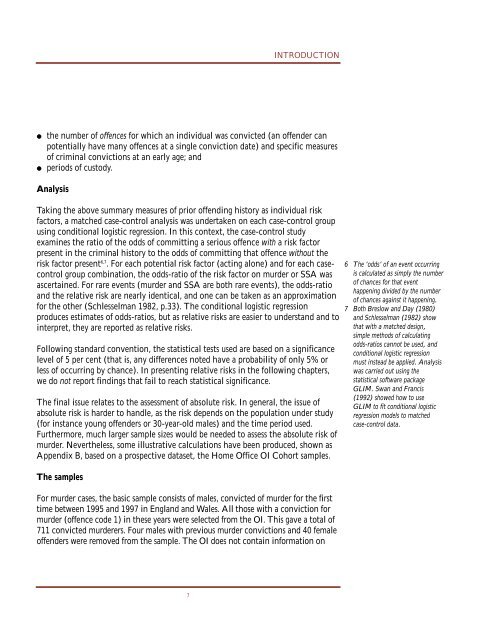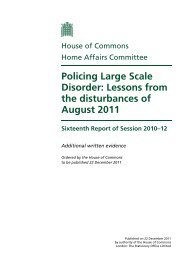Murder and Serious Sexual Assault - Lancaster EPrints - Lancaster ...
Murder and Serious Sexual Assault - Lancaster EPrints - Lancaster ...
Murder and Serious Sexual Assault - Lancaster EPrints - Lancaster ...
You also want an ePaper? Increase the reach of your titles
YUMPU automatically turns print PDFs into web optimized ePapers that Google loves.
INTRODUCTION<br />
● the number of offences for which an individual was convicted (an offender can<br />
potentially have many offences at a single conviction date) <strong>and</strong> specific measures<br />
of criminal convictions at an early age; <strong>and</strong><br />
● periods of custody.<br />
Analysis<br />
Taking the above summary measures of prior offending history as individual risk<br />
factors, a matched case-control analysis was undertaken on each case-control group<br />
using conditional logistic regression. In this context, the case-control study<br />
examines the ratio of the odds of committing a serious offence with a risk factor<br />
present in the criminal history to the odds of committing that offence without the<br />
risk factor present 6,7 . For each potential risk factor (acting alone) <strong>and</strong> for each casecontrol<br />
group combination, the odds-ratio of the risk factor on murder or SSA was<br />
ascertained. For rare events (murder <strong>and</strong> SSA are both rare events), the odds-ratio<br />
<strong>and</strong> the relative risk are nearly identical, <strong>and</strong> one can be taken as an approximation<br />
for the other (Schlesselman 1982, p.33). The conditional logistic regression<br />
produces estimates of odds-ratios, but as relative risks are easier to underst<strong>and</strong> <strong>and</strong> to<br />
interpret, they are reported as relative risks.<br />
Following st<strong>and</strong>ard convention, the statistical tests used are based on a significance<br />
level of 5 per cent (that is, any differences noted have a probability of only 5% or<br />
less of occurring by chance). In presenting relative risks in the following chapters,<br />
we do not report findings that fail to reach statistical significance.<br />
The final issue relates to the assessment of absolute risk. In general, the issue of<br />
absolute risk is harder to h<strong>and</strong>le, as the risk depends on the population under study<br />
(for instance young offenders or 30-year-old males) <strong>and</strong> the time period used.<br />
Furthermore, much larger sample sizes would be needed to assess the absolute risk of<br />
murder. Nevertheless, some illustrative calculations have been produced, shown as<br />
Appendix B, based on a prospective dataset, the Home Office OI Cohort samples.<br />
The samples<br />
For murder cases, the basic sample consists of males, convicted of murder for the first<br />
time between 1995 <strong>and</strong> 1997 in Engl<strong>and</strong> <strong>and</strong> Wales. All those with a conviction for<br />
murder (offence code 1) in these years were selected from the OI. This gave a total of<br />
711 convicted murderers. Four males with previous murder convictions <strong>and</strong> 40 female<br />
offenders were removed from the sample. The OI does not contain information on<br />
7<br />
6 The ‘odds’ of an event occurring<br />
is calculated as simply the number<br />
of chances for that event<br />
happening divided by the number<br />
of chances against it happening.<br />
7 Both Breslow <strong>and</strong> Day (1980)<br />
<strong>and</strong> Schlesselman (1982) show<br />
that with a matched design,<br />
simple methods of calculating<br />
odds-ratios cannot be used, <strong>and</strong><br />
conditional logistic regression<br />
must instead be applied. Analysis<br />
was carried out using the<br />
statistical software package<br />
GLIM. Swan <strong>and</strong> Francis<br />
(1992) showed how to use<br />
GLIM to fit conditional logistic<br />
regression models to matched<br />
case-control data.
















